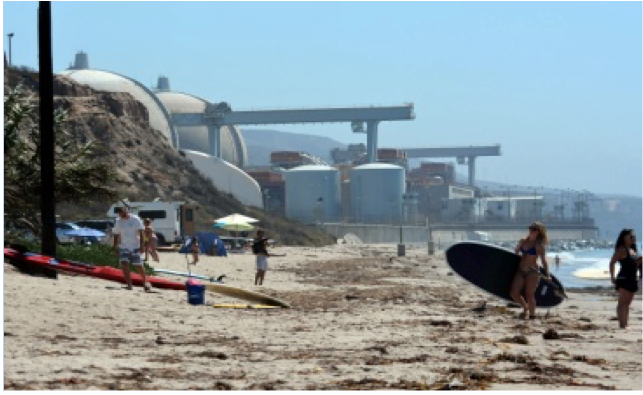CommentsCAP & MAIN REPORT--Our grandchildren moved to San Clemente earlier this year. They’re a stone’s throw over the county line from San Diego County. More important, they can walk to their favorite surf spot – “Trestles.” Disturbingly, they now live about three miles from the San Onofre Nuclear Generating Station. It no longer produces electricity, but a pile of radioactive waste sits there waiting to be moved somewhere.
From its construction, San Onofre had a checkered history. The huge Bechtel Corporation embarrassed itself by constructing one unit backwards. Then, a little over three decades later, the project installed a flawed Japanese-built unit. That led to closure. In the meantime, Southern California Edison’s parent company bought 75 percent of the plant and wants rate-payers instead of investors to foot the bill for its bad business decision. In 2015 the Coastal Commission granted a permit to bury the 3.6 million pounds of highly radioactive material onsite, along the coastline, right next to Trestles. Since then environmentalists have been urging the commission to reverse itself, insisting that the stuff must get hauled away.
There’s good reason. Radioactive leakage threatens human life in two ways. For 10 miles, wind-blown radiation can poison people and everything in its wake. For 50 miles – home to about 8.6 million people – it can contaminate food and liquids. My grandchildren’s new home sits well inside both those zones.
According to a 2001 piece from my old clip files, the California Journal reported children’s cancer death rates in San Luis Obispo County nearly doubled in the late 1980s after the Diablo Canyon plant opened there, and they dropped eight percent in Sacramento County after the Rancho Seco plant shut down.
The threat of cancer and pollution from nuclear waste plagues more places than just San Clemente. Recently my wife and I visited central Washington, not far from the Hanford nuclear reservation. The leaks at that site threaten to pollute the Columbia River – the major source of water for agriculture, fish, wildlife and drinking for hundreds of miles – all the way to the Pacific Ocean. A 2014 report found 362 design flaws in a partially built nuclear waste storage facility and the search for a potential location for disposal has stalled. Activists continue to be concerned that leakage will contaminate ground water and reach the river.
The problem for all of us is where to put waste that’s safe and secure for a few thousand years. Hanford obviously fails the test. Another location identified by the Energy Department (DOE) is in southeast New Mexico. Called Waste Isolation Pilot Plant (WIPP), it calls for burying high-level radioactive waste in underground salt mines. The project sounded good until 2014, when a waste-storage drum burst, sending engineers back to their drawing boards. Officials minimize the danger from leakage, but the threat underscores the dilemma. A DOE report blamed the $2 billion snafu on kitty litter. High-risk technology undone by the mundane.
Burying nuclear waste in Yucca Mountain remains the best hope for the nuclear industry. A long-term political football, development of this site was defunded in the Obama years, but has made a resurgence with President Trump’s new budget. Although Native Americans say the site is sacred and it sits just 90 minutes from Las Vegas, Trump proposes $120 million to reopen the project. At stake is moving 75,000 tons of highly radioactive materials from water casks to concrete and steel, then burying it in the mountain. Of course, since it has to sit there for a few thousand years, no one knows if this will contain the radioactivity. Nevadans claim it turns the area into a “national sacrifice zone.”
I remember standing on a hot day with perhaps a few hundred others protesting San Onofre’s first unit in the late 1960s. Its risk for close-by residents and the pristine coastline stood prominently in our minds, even then. We felt the concern – a decade before Diablo Canyon opened and voters closed Rancho Seco in Sacramento. The prospect of leakage was too great a threat. We worried then that no one had a plan for nuclear power waste.
Sadly our fears were prescient. Nothing – despite the billions of dollars spent – has succeeded in diminishing the threat. Decision makers like the Coastal Commission continue to search for a solution. This week the commission announced that another hearing scheduled on San Onofre’s waste would be postponed from its meeting in Monterey to its August hearing in Malibu, so more people from Orange and San Diego counties can attend and urge the commission not to let the waste be stored near public beaches, rivers or earthquake fault lines. Nor, for that matter, to be created in the first place.
To paraphrase Carl Sagan, we know who speaks for the nuclear industry. But who speaks for the human species? Who speaks for the Earth? Who speaks for my grandchildren? And will the commissioners be listening?
(Rev. Jim Conn is the founding minister of the Church in Ocean Park and served on the Santa Monica City Council and as that city's mayor. He helped found Clergy and Laity United for Economic Justice, Los Angeles, and was its second chair, and was a founder of Santa Monica's renter's rights campaign. This perspective originated at Capital and Main.)
-cw
















